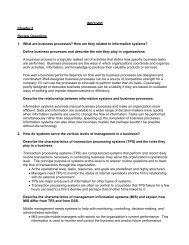Telecommunications and networks, the Internet
Telecommunications and networks, the Internet
Telecommunications and networks, the Internet
You also want an ePaper? Increase the reach of your titles
YUMPU automatically turns print PDFs into web optimized ePapers that Google loves.
INFO 1500 Introduction to IT FundamentalsLearning Objectives6. <strong>Telecommunications</strong> <strong>and</strong><strong>networks</strong>, <strong>the</strong> <strong>Internet</strong>1. What are <strong>the</strong> principal components of telecommunications<strong>networks</strong> <strong>and</strong> key networking technologies?2. What are <strong>the</strong> main telecommunications transmission media<strong>and</strong> types of <strong>networks</strong>?3. How does <strong>the</strong> <strong>Internet</strong> <strong>and</strong> <strong>Internet</strong> technology work <strong>and</strong>how do <strong>the</strong>y support communication <strong>and</strong> e‐business?Alex<strong>and</strong>er Nikov4. What are <strong>the</strong> principal technologies <strong>and</strong> st<strong>and</strong>ards forwireless networking, communication, <strong>and</strong> <strong>Internet</strong> access?5. Why are radio frequency identification (RFID) <strong>and</strong> wirelesssensor <strong>networks</strong> valuable for business?6-2Hyundai Heavy Industries Creates AWireless ShipyardHyundai Heavy Industries Creates AWireless Shipyard• Problem: Shipbuilding space is too large (4.2 sq mi)<strong>and</strong> complex to track inventory in real‐time, limitingefficiency• Solution: High‐speed wireless network built by KTCorp, using radio sensors, notebooks, mobiles, Webcams• Illustrates:–Powerful capabilities <strong>and</strong> solutions offered bycontemporary networking technology–Use of radio sensor technologies to track inventory6-3 6-4
OutlineNetworking <strong>and</strong> communication Trends• Convergence:1. <strong>Telecommunications</strong> <strong>and</strong> Networking in Today’sBusiness World2. Communications Networks3. The Global <strong>Internet</strong>4. Wireless Networks– Telephone <strong>networks</strong> <strong>and</strong> computer <strong>networks</strong>converging into single digital network using <strong>Internet</strong>st<strong>and</strong>ards–E.g. cable companies providing voice service• Broadb<strong>and</strong>:–More than 60% U.S. <strong>Internet</strong> users have broadb<strong>and</strong>access• Broadb<strong>and</strong> wireless:6-5–Voice <strong>and</strong> data communication as well as <strong>Internet</strong>access are increasingly taking place over broadb<strong>and</strong>wireless platforms6-6What is a computer network?Components of a Simple Computer Network•Two or more connected computers•Major components in simple network– Client computer– Server computer– Network interfaces (NICs)– Connection medium– Network operating system– Hub or switch•Routers– Device used to route packets of data through different<strong>networks</strong>, ensuring that data sent gets to <strong>the</strong> correct address6-7FIGURE 7-1Illustrated here is a very simple computer network, consisting of computers, anetwork operating system residing on a dedicated server computer, cable(wiring) connecting <strong>the</strong> devices, network interface cards (NICs), switches, <strong>and</strong>a router.6-8
Components of <strong>networks</strong> in large companies• Hundreds of local area <strong>networks</strong> (LANs) linked tofirmwide corporate network•Various powerful servers– Web site– Corporate intranet, extranet– Backend systems• Mobile wireless LANs (Wi‐Fi <strong>networks</strong>)• Videoconferencing systemToday’s corporatenetworkinfrastructure is acollection of manydifferent <strong>networks</strong>from <strong>the</strong> publicswitched telephonenetwork, to <strong>the</strong><strong>Internet</strong>, tocorporate local area<strong>networks</strong> linkingworkgroups,departments, oroffice floors.Corporate Network Infrastructure• Telephone network•Wireless cell phones6-9FIGURE 7-26-10Key networking technologiesKey networking technologies (cont.)• Client/server computing– Distributed computing model– Clients linked through network controlled by <strong>networks</strong>erver computer–Server sets rules of communication for network <strong>and</strong>provides every client with an address so o<strong>the</strong>rs canfind it on <strong>the</strong> network–Has largely replaced centralized mainframecomputing–The <strong>Internet</strong>: Largest implementation of client/servercomputing•Packet switching–Method of slicing digital messages into parcels(packets), sending packets along differentcommunication paths as <strong>the</strong>y become available, <strong>and</strong><strong>the</strong>n reassembling packets at destination–Previous circuit‐switched <strong>networks</strong> required assemblyof complete point‐to‐point circuit–Packet switching more efficient use of network’scommunications capacity6-116-12
Packed‐switched Networks And PacketCommunicationsKey networking technologies (cont.)• TCP/IP <strong>and</strong> connectivity– Connectivity between computers enabled by protocols– Protocols: Rules that govern transmission of informationbetween two points– Transmission Control Protocol/<strong>Internet</strong> Protocol (TCP/IP)• Common worldwide st<strong>and</strong>ard that is basis for <strong>Internet</strong>– Department of Defense reference model for TCP/IP•Four layers1. Application layer2. Transport layer3. <strong>Internet</strong> layer4. Network interface layerFIGURE 7-3Data are grouped into small packets, which are transmitted independently overvarious communications channels <strong>and</strong> reassembled at <strong>the</strong>ir final destination.6-136-14The Transmission Control Protocol/ <strong>Internet</strong>Protocol (TCP/IP) Reference ModelOutlineThis figure illustrates <strong>the</strong> fourlayers of <strong>the</strong> TCP/IPreference model forcommunications1. <strong>Telecommunications</strong> <strong>and</strong> Networking in Today’s BusinessWorld2. Communications Networks3. The Global <strong>Internet</strong>4. Wireless NetworksFIGURE 7-46-156-16
Signals <strong>and</strong> Types of <strong>networks</strong>Types of Networks• Signals: digital vs. analog–Modem: Translates digital signals into analog form• Types of <strong>networks</strong>–Local‐area <strong>networks</strong> (LANs)• Campus‐area <strong>networks</strong> (CANs)• Peer‐to‐peer• Topologies: star, bus, ring– Metropolitan <strong>and</strong> wide‐area <strong>networks</strong>•Wide‐area <strong>networks</strong> (WANs)• Metropolitan‐area <strong>networks</strong> (MANs)6-1718 6-18Functions Of The ModemNETWORK TOPOLOGIESThe three basicnetwork topologiesare <strong>the</strong> star, bus, <strong>and</strong>ring.FIGURE 7-5A modem is a device that translates digital signals into analog form (<strong>and</strong>vice versa) so that computers can transmit data over analog <strong>networks</strong> suchas telephone <strong>and</strong> cable <strong>networks</strong>.6-19FIGURE 7-66-20
Physical transmission mediaBP’s Satellite Transmission System•Twisted wire (modems)• Coaxial cable• Fiber optics <strong>and</strong> optical <strong>networks</strong>–Dense wavelength division multiplexing (DWDM)•Wireless transmission media <strong>and</strong> devices–Microwave– Satellites– Cellular telephones• Transmission speed (hertz, b<strong>and</strong>width)FIGURE 7-7Communication satellites help BP transfer seismic data between oil explorationships <strong>and</strong> research centers in <strong>the</strong> United States.6-216-22OutlineThe Global <strong>Internet</strong>1. <strong>Telecommunications</strong> <strong>and</strong> Networking in Today’s BusinessWorld2. Communications Networks3. The Global <strong>Internet</strong>4. Wireless Networks•What is <strong>the</strong> <strong>Internet</strong>?• <strong>Internet</strong> Addressing <strong>and</strong> Architecture–The Domain Name System• Hierarchical structure•Top‐level domains– <strong>Internet</strong> Architecture <strong>and</strong> Governance•No formal management: IAB, ICANN, W3C–The Future <strong>Internet</strong>: IPv6 <strong>and</strong> <strong>Internet</strong>26-236-24
The Domain Name System• How <strong>the</strong> internet works• http://www.youtube.com/watch?v=Jj6EHgSsx_U&feature=relatedDomain NameSystem is ahierarchicalsystem with a rootdomain, top-leveldomains, secondleveldomains, <strong>and</strong>host computers at<strong>the</strong> third level.• How <strong>the</strong> <strong>Internet</strong> Works in 5 Minuteshttp://www.youtube.com/watch?v=7_LPdttKXPc&feature=relatedFIGURE 7-8256-26<strong>Internet</strong> Network Architecture<strong>Internet</strong> servicesThe <strong>Internet</strong>backbone connectsto regional <strong>networks</strong>,which in turn provideaccess to <strong>Internet</strong>service providers,large firms, <strong>and</strong>governmentinstitutions. Networkaccess points(NAPs) <strong>and</strong>metropolitan areaexchanges (MAEs)are hubs where <strong>the</strong>backbone intersectsregional <strong>and</strong> local<strong>networks</strong> <strong>and</strong> wherebackbone ownersconnect with oneano<strong>the</strong>r.FIGURE 7-96-27•E‐mail• Chatting <strong>and</strong> instant messaging• Newsgroups• Telnet• File Transfer Protocol (FTP)•World Wide Web•VoIP•Virtual private network (VPN)6-28
Major <strong>Internet</strong> ServicesClient/Server Computing On The <strong>Internet</strong>FIGURE 7-10Client computers running Web browser <strong>and</strong> o<strong>the</strong>r software can access anarray of services on servers over <strong>the</strong> <strong>Internet</strong>. These services may all run ona single server or on multiple specialized servers.296-30How Voice Over IP WorksA Virtual Private Network Using The <strong>Internet</strong>FIGURE 7-11An VoIP phone call digitizes <strong>and</strong> breaks up a voice message into datapackets that may travel along different routes before being reassembled at<strong>the</strong> final destination. A processor nearest <strong>the</strong> call’s destination, called agateway, arranges <strong>the</strong> packets in <strong>the</strong> proper order <strong>and</strong> directs <strong>the</strong>m to <strong>the</strong>telephone number of <strong>the</strong> receiver or <strong>the</strong> IP address of <strong>the</strong> receivingcomputer.This VPN is a privatenetwork of computerslinked using a secure“tunnel” connectionover <strong>the</strong> <strong>Internet</strong>. Itprotects datatransmitted over <strong>the</strong>public <strong>Internet</strong> byencoding <strong>the</strong> data <strong>and</strong>“wrapping” <strong>the</strong>m within<strong>the</strong> <strong>Internet</strong> Protocol(IP). By adding awrapper around anetwork message tohide its content,organizations cancreate a privateconnection that travelsthrough <strong>the</strong> public<strong>Internet</strong>.FIGURE 7-126-316-32
The World Wide WebThe World Wide Web (cont.)•HTML (Hypertext Markup Language):–Formats documents for display on Web• Hypertext Transfer Protocol (HTTP):– Communications st<strong>and</strong>ard used for transferring Webpages•Uniform resource locators (URLs):– Addresses of Web pages•E.g.http://www.megacorp.com/content/features/082602.html•Web servers–Software for locating <strong>and</strong> managing Web pages•Search engines–Started in early 1990s as relatively simple softwareprograms using keyword indexes–Today, major source of <strong>Internet</strong> advertising revenuevia search engine marketing, using complexalgorithms <strong>and</strong> page ranking techniques to locateresults• Shopping bots–Use intelligent agent software for searching <strong>Internet</strong>for shopping information6-336-34How Google WorksTop U.S. Web Search EnginesThe Google searchengine iscontinuouslycrawling <strong>the</strong> Web,indexing <strong>the</strong> contentof each page,calculating itspopularity, <strong>and</strong>storing <strong>the</strong> pages sothat it can respondquickly to userrequests to see apage. The entireprocess takes aboutone-half second.FIGURE 7-136-35FIGURE 7-14Google is <strong>the</strong> most popular search engine on <strong>the</strong> Web, h<strong>and</strong>ling 72 percentof all Web searches.6-36
Browser Statisticshttp://www.w3schools.com/browsers/browsers_stats.aspWeb 2.0•Four defining features1. Interactivity2. Real‐time user control3. Social participation4. User‐generated content• Technologies <strong>and</strong> services behind <strong>the</strong>se features– Cloud computing– Blogs/RSS– Mashups & widgets– Wikis– Social <strong>networks</strong>37 6-376-38Web 3.0 <strong>and</strong> O<strong>the</strong>r visionsOutline•Web 3.0 − <strong>the</strong> Semanc Web– Effort of W3C to add meaning to existing Web–Make searching more relevant to user• O<strong>the</strong>r visions–More“intelligent” computing–3D Web– Pervasive Web–Increase in cloud computing, SaaS– Ubiquitous connectivity between mobile <strong>and</strong> o<strong>the</strong>r accessdevices–Make Web a more seamless experience1. <strong>Telecommunications</strong> <strong>and</strong> Networking in Today’s BusinessWorld2. Communications Networks3. The Global <strong>Internet</strong>4. Wireless Networks6-396-40
Cellular systems• Competing st<strong>and</strong>ards for cellular service–CDMA: United States–GSM: Rest of world, plus AT&T <strong>and</strong> T‐Mobile•Third‐generation (3G) <strong>networks</strong>– Suitable for broadb<strong>and</strong> <strong>Internet</strong> access– 144 Kbps – 2Mbps•4G <strong>networks</strong>–Entirely packet‐switched– 100 Mbps – 1GbpsWireless computer <strong>networks</strong> <strong>and</strong> <strong>Internet</strong>access• Bluetooth (802.15)–Links up to 8 devices in 10‐m area–Useful for personal networking (PANs) <strong>and</strong> in businessto transmit data from h<strong>and</strong>held devices to o<strong>the</strong>rtransmitters•Wi‐Fi (802.11)–Set of st<strong>and</strong>ards: 802.11a, 802.11b, 802.11g, 802.11n–Used for wireless LAN <strong>and</strong> wireless <strong>Internet</strong> access–Use access points: Device with radioreceiver/transmitter for connecting wireless devices toa wired LAN6-416-42A Bluetooth Network (PAN)An 802.11 Wireless LANBluetooth enables avariety of devices,including cellphones, PDAs,wireless keyboards<strong>and</strong> mice, PCs, <strong>and</strong>printers, to interactwirelessly with eacho<strong>the</strong>r within a small30-foot (10-meter)area. In addition to<strong>the</strong> links shown,Bluetooth can beused to <strong>networks</strong>imilar devices tosend data from onePC to ano<strong>the</strong>r, forexample.FIGURE 7-156-43Mobile laptopcomputers equippedwith network interfacecards link to <strong>the</strong> wiredLAN bycommunicating with<strong>the</strong> access point. Theaccess point usesradio waves totransmit <strong>networks</strong>ignals from <strong>the</strong> wirednetwork to <strong>the</strong> clientadapters, whichconvert <strong>the</strong>m into datathat <strong>the</strong> mobile devicecan underst<strong>and</strong>. Theclient adapter <strong>the</strong>ntransmits <strong>the</strong> datafrom <strong>the</strong> mobiledevice back to <strong>the</strong>access point, whichforwards <strong>the</strong> data to<strong>the</strong> wired network.FIGURE 7-166-44
Wireless computer <strong>networks</strong> <strong>and</strong> <strong>Internet</strong>access•Wi‐Fi (cont.)– Hotspots: Access points in public place to providemaximum wireless coverage for a specific area–Weak security features• WiMax (802.16)– Wireless access range of 31 miles– Require WiMax antennas–Sprint Nextel building WiMax network as foundationfor 4G <strong>networks</strong>Radio frequency identification (RFID)• Use tiny tags with embedded microchips containingdata about an item <strong>and</strong> location, <strong>and</strong> antenna•Tags transmit radio signals over short distances tospecial RFID readers, which send data over networkto computer for processing•Active RFID: Tags have batteries, data can berewritten, range is hundreds of feet, more expensive• Passive RFID: Range is shorter, also smaller, lessexpensive, powered by radio frequency energy6-456-46Radio frequency identification (RFID) (cont.)How RFID Works• Common uses:– Automated toll‐collection–Tracking goods in a supply chain• Requires companies to have special hardware <strong>and</strong>software• Reduction in cost of tags making RFID viable formany firmsFIGURE 7-17RFID uses low-powered radio transmitters to read data stored in a tag atdistances ranging from 1 inch to 100 feet. The reader captures <strong>the</strong> data from<strong>the</strong> tag <strong>and</strong> sends <strong>the</strong>m over a network to a host computer for processing.6-476-48
Wireless sensor <strong>networks</strong> (WSNs)A Wireless Sensor Network• Networks of hundreds or thous<strong>and</strong>s ofinterconnected wireless devices embedded intophysical environment to provide measurements ofmany points over large spaces– Devices have built‐in processing, storage, <strong>and</strong> radiofrequency sensors <strong>and</strong> antennas– Require low‐power, long‐lasting batteries <strong>and</strong> abilityto endure in <strong>the</strong> field without maintenance• Used to monitor building security, detect hazardoussubstances in air, monitor environmental changes,traffic, or military activityThe small circlesrepresent lowerlevelnodes <strong>and</strong><strong>the</strong> larger circlesrepresent highendnodes.Lower levelnodes forwarddata to eacho<strong>the</strong>r or tohigher-levelnodes, whichtransmit datamore rapidly <strong>and</strong>speed upnetworkperformance.FIGURE 7-186-496-50Video case: Unified Communications Systems With VirtualCollaboration: IBM <strong>and</strong> ForterraVideo case: Unified Communications SystemsWith Virtual Collaboration: IBM <strong>and</strong> Forterra1. What are <strong>the</strong> gains in productivity that can result through aunified communications system?2. How does this system support collaboration?3. How realistic is <strong>the</strong> collaborative design meeting?4. What different kinds of communications tools does thissystem integrate?5. What does virtual reality add to <strong>the</strong> unified communicationsystem?http://www.youtube.com/watch?v=dhndnl__HkA6-516-52
Video Case: Unified Communications Systems With Virtual Collaboration: IBM <strong>and</strong> Forterra1. What are <strong>the</strong> gains in productivity that can resultthrough a unified communications system?Video Case: Unified Communications Systems With Virtual Collaboration: IBM <strong>and</strong> Forterra2. How does this system support collaboration?Easier to find people, arrange meetings, communicate ondifferent platforms simultaneously. Easier to collaborate, <strong>and</strong>faster to reach decisions.Streng<strong>the</strong>ns sense of presence, stronger relationships,memorable experiences, faster problem solving <strong>and</strong> decisionmaking. Overcomes geographical <strong>and</strong> time limitations oftraditional meetings.6-536-54Video Case: Unified Communications Systems With Virtual Collaboration: IBM <strong>and</strong> Forterra3. How realistic is <strong>the</strong> collaborative designmeeting?Video Case: Unified Communications Systems With Virtual Collaboration: IBM <strong>and</strong> Forterra4. What different kinds of communications toolsdoes this system integrate?On balance, an interesting believable dialog among designers,marketers <strong>and</strong> vendors. It would seem to depend on peoplebeing at <strong>the</strong> computers to work. For instance, if some peoplewere on <strong>the</strong>ir cell phones, this system might not work so wellexcept for voice.• Phones,• desktops,• email,• mobile phones,• audio <strong>and</strong>• Web conferencing.6-556-56
Video Case: Unified Communications Systems With Virtual Collaboration: IBM <strong>and</strong> Forterra5. What does virtual reality add to <strong>the</strong> unifiedcommunication system?Virtual reality is not as “real” as telepresence which involveshuman beings appearing on screens. However, if humanscannot be present in <strong>the</strong> meeting room, <strong>the</strong>y might be able toparticipate in conferences as avatars. Although <strong>the</strong>re is a tradeoff(less realism), it may be more practical..6-57
















